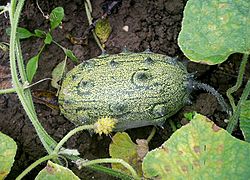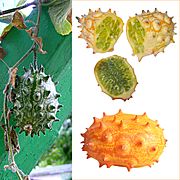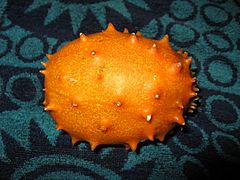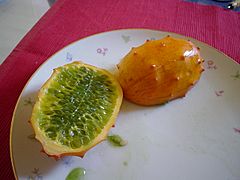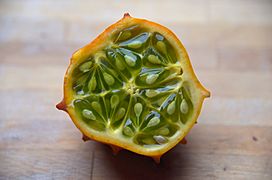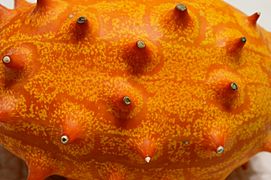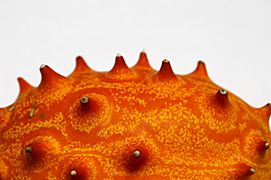Horned melon facts for kids
Quick facts for kids Horned melon |
|
|---|---|
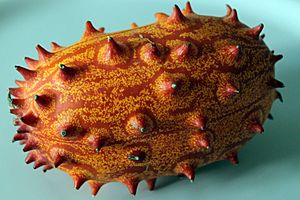 |
|
| Cucumis metuliferus fruit | |
 |
|
| Scientific classification | |
| Genus: |
Cucumis
|
| Species: |
metuliferus
|
| Nutritional value per 100 g (3.5 oz) | |
|---|---|
| Energy | 183 kJ (44 kcal) |
|
7.56 g
|
|
|
1.26 g
|
|
|
Protein
|
1.78 g
|
| Vitamins | Quantity
%DV†
|
| Vitamin A equiv.
beta-Carotene
|
1%
7 μg
1%
88 μg |
| Thiamine (B1) |
2%
0.025 mg |
| Riboflavin (B2) |
1%
0.015 mg |
| Niacin (B3) |
4%
0.565 mg |
| Pantothenic acid (B5) |
4%
0.183 mg |
| Vitamin B6 |
5%
0.063 mg |
| Folate (B9) |
1%
3 μg |
| Vitamin C |
6%
5.3 mg |
| Minerals | Quantity
%DV†
|
| Calcium |
1%
13 mg |
| Copper |
1%
0.020 mg |
| Iron |
9%
1.13 mg |
| Magnesium |
11%
40 mg |
| Manganese |
2%
0.039 mg |
| Phosphorus |
5%
37 mg |
| Potassium |
4%
123 mg |
| Sodium |
0%
2 mg |
| Zinc |
5%
0.48 mg |
| Other constituents | Quantity |
| Water | 88.97 g |
|
Link to USDA Database entry
|
|
| †Percentages estimated using US recommendations for adults. | |
Cucumis metuliferus, commonly called the African horned cucumber, horned melon, spiked melon, jelly melon, kiwano, or cuke-a-saurus is an annual vine in the cucumber and melon family, Cucurbitaceae. Its fruit has horn-like spines, hence the name "horned melon". The ripe fruit has orange skin and lime green, jelly-like flesh. C. metuliferus is native to Southern Africa. It is found in South Africa, Namibia, Botswana, Zambia, Zimbabwe, Mozambique, and Angola.
Kiwano is a traditional food plant in Africa. Along with the Gemsbok cucumber (Acanthosicyos naudinianus) and Tsamma (Citron melon) it is one of the few sources of water during the dry season in the Kalahari Desert. In northern Zimbabwe it is called gaka or gakachika, and is primarily used as a snack or salad, and rarely for decoration. It can be eaten at any stage of ripening, but when overripe, it will burst forcefully to release seeds.
The fruit's taste has been compared to a combination of banana and passionfruit or a combination of banana, cucumber and lime. A small amount of salt or sugar can increase the flavor but the seed content can make eating the fruit less convenient than many common fruits.
Some also eat the peel, which is very rich in vitamin C and dietary fiber.
Contents
Germination
Seeding optimum germination temperatures are between 20° and 35 °C (68° to 95 °F). Germination is delayed at 12 °C (54 °F), and inhibited at temperatures lower than 12 °C or above 35 °C. Thus, it is recommended to sow in trays and transplant into the field at the two true leaf stage. The best time for transplanting into an open field is in the spring when soil and air temperatures rise to around 15 °C (59 °F).
Pests and diseases
It was found that kiwano is resistant to several root-knot nematodes, two accessions were found to be highly resistant to Watermelon mosaic virus (WMV-1), but very sensitive to the Squash mosaic virus (SqMV). Some accessions were found to succumb to Fusarium wilt. Resistance to Greenhouse whitefly was reported. Kiwano was reported to be resistant to powdery mildew; however, in Israel powdery mildew as well as the Squash mosaic virus (SqMV) attacked kiwano fields and measures had to be taken.
Gallery
See also
 In Spanish: Cucumis metuliferus para niños
In Spanish: Cucumis metuliferus para niños


